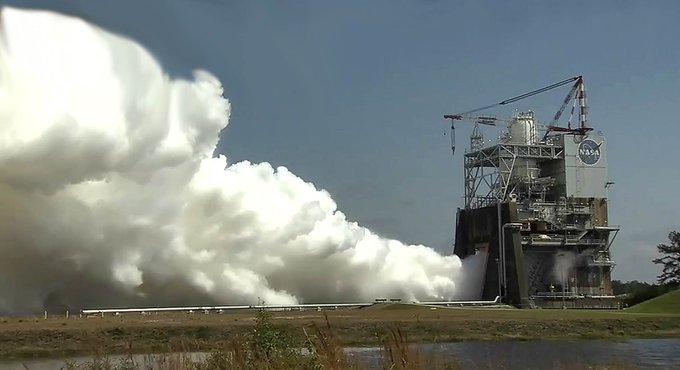On November 16th, NASA launched the first mission of the Artemis Program (Artemis I), which splashed down three and a half weeks later. This uncrewed mission saw the Space Launch System (SLS) send an Orion spacecraft far beyond the orbit of the Moon, establishing a new record for distance traveled by a mission and the amount of time spent beyond Low Earth Orbit (LEO). Powering the core stage of the SLS were four Aerojet Rocketdyne RS-25s, the same engines used by the Space Shuttle – known as the Space Shuttle Main Engine (SSME).
By the end of the decade, NASA plans to mount a total of six Artemis launches that will include crewed missions to the surface, the creation of the Artemis Basecamp, and the deployment of the Lunar Gateway. NASA also plans to upgrade key components in the mission architecture along the way, which include replacing the Space Shuttle Era engines with the newly-designed RS-25E. On December 14th, NASA tested this engine for the first time at the Stennis Space Center in Mississippi, completing a hot fire test that lasted for just under three and a half minutes (209.5 seconds).
The test took place on the Fred Haise Test Stand just days after NASA successfully completed the Artemis I flight test. Also known as a “confidence test,” the single-engine firing was designed to confirm that the RS-25 is ready to proceed with certification tests – which are scheduled to take place early next year. Previously, NASA and lead contractor Aerojet Rocketdyne created 16 of the RD-25D variant for use on the Artemis I through Artemis IV missions. These latest tests are for the RS-25Es, which will be used by the Artemis V and VI missions, which will take place sometime in 2028 and 2029 (respectively).

These missions will deliver crews of four astronauts to the surface of the Moon, as well as the Lunar Terrain Vehicle (LTV) and the last elements of the Gateway – the European System Providing Refueling Infrastructure and Telecommunication (ESPRIT) and the Gateway Airlock modules. Johnny Heflin, manager of the SLS Liquid Engines Office at NASA’s Marshall Space Flight Center, explained the importance of hot testing in a recent NASA press release:
“Much like launch, test campaigns are dynamic events that allow us to learn more about the SLS rocket hardware. NASA and Aerojet Rocketdyne teams were successful in running the first test of the new RS-25 restart engine for 209.5 seconds that will help power future missions with the SLS rocket. Preliminary data indicates the engine was performing nominally. Data analysis is underway.“
As with previous tests, the hot fire was scheduled to run for 500 seconds but was shut down early by a non-flight system used to monitor the engine. NASA and Aerojet Rocketdyne are analyzing the data now to review the monitoring system, evaluate the engine’s performance, and identify the reason for the early cutoff. Since the test did not involve engines destined to be used by any missions in the near future, the termination will not affect NASA’s flight schedule.
In addition, the test provided vital data that will aid in the production of new RS-25 engines. With the Artemis I flight test complete, both NASA and Aerojet Rocketdyne – its main contractor for developing propulsion elements for Artemis – are moving forward with testing and developing new mission elements. Hot fire tests are vital to these efforts since they will test new components used in future engines. This includes a new powerhead component that’s already been integrated and additional components (a new nozzle and controller) that will be installed before the certification series.
This latest test was also the first time since March that the Fred Haise Test Stand was used when NASA completed a developmental test series designed to modernize the manufacture and reduce the costs of producing RS-25 engines. Since then, Stennis teams have completed critical maintenance projects to support the RS-25 testing program, like upgrading the stand’s high-pressure industrial water systems, its flame deflector, thrust vector control system, and data-acquisition system.
“Each test, even one that does not go full duration, helps us gather valuable data and helps us prepare to fly safely,” said Stennis RS-25 project manager Chip Ellis.”
The first crewed mission of the Artemis Program (Artemis II) is currently scheduled for May 2024. This mission will see a crew of four conduct a lunar flyby before returning to Earth. This will be followed by Artemis III sometime in 2025, which will see a crew of four flying to lunar orbit and rendezvous with the Starship HLS. Two crewmembers, “the first woman and person of color,” will then use the HLS to land on the lunar surface. They will be the first astronauts to walk on the Moon since Gene Cernan and Harrison Schmitt did so in 1972 as part of the Apollo 17 mission.
Every SLS flight will be powered by four core stage RS-25 engines, plus two expendable solid rocket boosters (also used during the Space Shuttle Era). These engines will fire simultaneously to generate a combined 725,748 kg (1.6 million lbs) of thrust at launch and 907,185 kg (2 million lbs) during ascent. Beyond simply sending astronauts to the Moon for the first time since the Apollo Era, the long-term goal of these missions is to create the infrastructure that will allow for a “sustained program of lunar exploration” and pave the way for crewed missions to Mars.
We’re going back, and we intend to stay. Then we’re going further. The RS-25, once the workhorse of the Space Shuttle Program, will be a key element of these plans, providing the kind of thrust needed to send astronauts beyond LEO for the first time in over 50 years!
Further Reading: NASA

